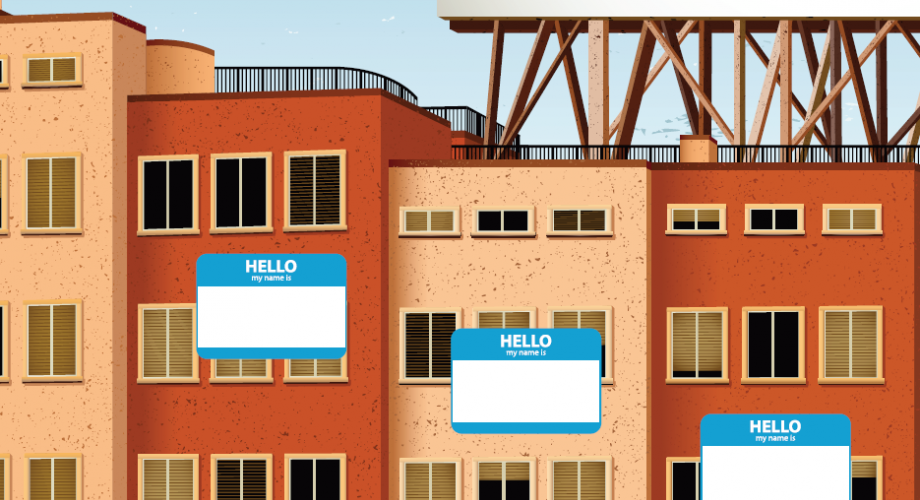Apartment Communities often resort to more than SEO-weighted Strategies
Dogs, children’s names and simple street addresses can provide inspiration to owners and developers when determining the names of apartment communities. The search-engine optimization strategy is common – and why not? It is all about having the community’s name appear when prospective residents go looking in a given neighborhood. But recently, a trend toward the humanization of community names has been developing.
For example, The Catherine, located in Austin, Texas, was named after the daughter of the developer at StreetLight.
Another example, The Harvey in Boston, was named for the Director of Design for the Baltimore architecture firm Hord Coplan Macht.
It’s trendy and catchy to name an apartment building after a person, and it’s easily memorable for prospective and current residents.
According to Jamie Gorski, Chief Marketing Officer, Bozzuto, naming communities after individuals such as The Alfred “can attract customers who may think there is a person behind the brand,” she says. “It gives the impression of a brand that is less corporate and more personal, allowing customers to connect.”
Renee Zahn, Senior Director – Real Estate—Greystar Real Estate Partners, says one development group she worked with wanted to give the properties personal family recognition and had several buildings named after their children, “The Catherine” being one.
"I think that it caught on after this particular building did it, and the thought behind it is that like a person, a building has a personality,” she says.
When naming a property, it is traditional for the owner/developer to look at the surrounding community and culture of the area for distinct characteristics. The name ties to something that references a significant quality of the area, either historically or modern-day.
“I’ve encountered quite a few examples during my career working in the industry,” Amy Groff, NAA’s Senior Vice President, Industry Operations, says. “The George in Wheaton was an owner’s dog’s name. I named The Oasis at Montclair in Woodbridge because of its location and quiet, resort-like feel. We had an owner that named his properties: Allure, Aspire, Ascend – I guess he liked names beginning with ‘A’!”
While the apartment company’s marketing team generally leads the process, Gorski says that the decision ultimately falls to the owner. “After all, it’s their multi-million-dollar asset.,” she says.
Typically, a marketing firm is hired to brainstorm names and they present their top 10 list to owners/managers for decisions; the list is based on brand and location, or it can be driven by the design and vibe of the building.
“We would give the list to an internal group to help make decisions or the owners would make the decision,” Groff says. “Branding is very important – we began community names with ‘The Fields of’ and added the location for all of our tax-credit communities; at one point, we called all of our luxury brands ‘Metropolitan at’ followed by the location.”
There are certainly other considerations. [AvalonBay] pairs its consumer brands with a location, which can be a specific city, a neighborhood or a recognizable location.
“In addition to aligning with the brand’s strategy, it helps from a search perspective as the location is ideally selected as a place people would look for apartments when searching Google. “Apartments in Ballston” for example,” Lindsay Gallagher, Marketing Director, AvalonBay Communities, says.
Camden’s Vice President of Marketing Julie Keel says a top factor in an apartment search is the location.
“We determine our community names based on the neighborhood or street name of the community,” Keel says. “This not only makes it easy for customers to know where we are located, but it even more, we receive the SEO benefit on both paid and organic search. We also understand brand is important to our customers, therefore every community includes the brand name.
Another method is to create legacy, Jacklyn Arnest, Director of Marketing and Lease Up Development at DTN Management, East Lansing, Mich., says.
“Naming a property after an owner, developer or architect creates ownership in the project and cements a vision of legacy for long-term hold and generational owners,” she says. “And, seeing their name (first or last) makes the development more of a passion project that receives more attention to detail because of the personal connection and reputation.”
Another is programming. “Storytelling is key to creating separating from the competition in dense urban projects,” Arnest says. “If we tie the marketing and design is tied to a historical or geographical name or event, it creates an emotional tie to the property and the surrounding community that makes the project memorable.
"Using proper names with geographical ties supports a strong digital component, giving a site more relevancy at the conception of a marketing campaign. If the property is meant to be a flagship for a new city district, the owner or developer will work directly with the city on their long-term strategic plans and include lateral branding in the project.
“Another critical consideration involves trademarking and availability. Finding a name an owner or management company desires can be tricky, especially numerical naming, as these domains can be very expensive (more than $30,000) and the trademarking/copywriting can prove difficult.”
